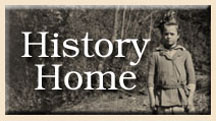

Economics and Social Class in Southern Appalachia
On traveling through the Southern Appalachian Mountains in 1898,
sociologist George Vincent observed that the region’s inhabitants, while
more similar to one another in terms of wealth and material culture than they
were to outsiders, nevertheless exhibited unmistakable class distinctions.
These classes were based primarily on the size and location of family farms
which, given the mountaineers’ overwhelming dependence on agriculture
as a way of life, is not surprising. The wealthiest class (a group Vincent
dubbed the valley farmers) owned fertile, relatively flat lands in the region’s
river bottoms, while the middle class (dubbed cove farmers by Vincent) tilled
lands “in the cove or hollow at the mouth of a ‘branch.’”
Finally, there were the families of the poorest economic class (Vincent’s
hill farmers) who eked out a meager existence on the steepest, least agriculturally
productive lands. Of course, Vincent was quick to acknowledge that “these
three types are by no means clearly defined,” meaning that valley, cove,
and hill farms often blended rather seamlessly into one another, and so were
not as easy to distinguish from one another as his descriptive categories
imply. Still, these categories are useful, for they shed light on the economic
differences that existed in Southern Appalachia. In this essay, we will apply
them to the small, isolated Southern Appalachian community of Gatlinburg,
Tennessee.
The wealthiest Gatlinburg families (Vincent’s valley farmers) owned
lands adjacent to the Little Pigeon River in the area now occupied by the
modern Gatlinburg Parkway. Predominantly farmers, they raised corn, vegetables,
hogs, cattle, and chickens for home consumption, and whenever possible, sold
produce and livestock for profit in nearby towns. What set them apart from
their neighbors, however, was (typically) their involvement in non-agricultural,
for-profit activities. In most cases, the family patriarch owned or had money
invested in logging camps, general stores, boarding houses, or some other
commercial venture. He might also serve the community in some capacity, perhaps
as a sheriff’s deputy, mailman, or member of the Sevier County School
Board. Although he and his family were far from wealthy, particularly when
compared to landowners in the nearby French Broad-Holston River valleys (some
of whom cultivated in excess of 1,000 acres and shipped most of their produce
to markets in Knoxville, Chattanooga, and Atlanta), they enjoyed a comfortable
standard of living. Valley farm homes tended to be multi-story frame dwellings,
furnished with store-bought chairs, tables, and other fineries. Their clothing
set them apart as well, for unlike many of their neighbors, valley farm families
could afford to purchase suits, dresses, and hats from Knoxville and Sevierville
retail firms.
Cove farm families lived further back in the mountains than valley farmers,
and were therefore more physically isolated and less materially wealthy than
their valley neighbors. Still, these families were not poor--at least not
by Southern Appalachian standards—and enjoyed a relatively comfortable
standard of living. Subsistence farmers for the most part, cove families consumed
practically everything that they produced on their farms (again, corn, hogs,
and vegetables), although they might occasionally trade chickens, eggs, or
fresh pork for salt, tools, and other hard to acquire items. A fortunate few
enjoyed access to a fast-moving creek, and were thus able to construct mills
for grinding corn and wheat into flour. As for their homes and material culture,
cove farm families more closely resembled the stereotypical “Southern
Appalachian mountaineer” than did their valley neighbors. Homes were
constructed of heavy logs rather than sawed lumber, mainly because the roads
leading up into the coves were little more than narrow, rock-infested footpaths--and
thus unable to support lumber wagons--but also because cove families lacked
the capital needed to build frame homes. Home furnishings were sparse, consisting
typically of little more than a few beds, a table, some chairs, and cast-iron
cooking utensils, and clothing was mostly handmade from bolts of store-bought
cloth. Contrary to popular belief, very few Southern Appalachian families
wove their own cloth by the late nineteenth to early twentieth centuries.
Finally, there were the hill farmers who scratched out a living on the region’s
most marginal lands. Although these families cultivated crops and raised livestock
for home consumption, their efforts were seldom rewarded with the security
and economic independence enjoyed by neighbors further down the valley. Simply
put, they possessed too little land--much of it of dubious quality--to produce
adequate nutrition for their large families (which often exceeded ten members)
and livestock. Given their precarious circumstances, it was not uncommon for
hill families to depend heavily on neighbors or their extended family for
food, financial support, access to flour mills, and access to beasts of burden;
or for the family patriarch and older sons to spend part of the year away
at lumber camps, earning a meager income performing hard and dangerous labor.
It should also come as no surprise that hill farmers’ log homes tended
to be much smaller than those of the cove farmers, or that their clothing
tended to be a hodge-podge of handmade items and cast-offs.
As you can see, then, to lump Southern Appalachian mountaineers haphazardly
into one monolithic socio-economic group, as did many travel writers and sociologists
who visited the region in the late nineteenth and early twentieth centuries,
is to construct a false view of the region and its people. Some Southern Appalachian
mountaineers were quite wealthy, relatively speaking, and lived comfortable
lives; others were quite poor, and were stalked constantly by malnutrition,
disease, and in some cases, despair. And yet, regardless of their economic
status, the denizens of this geographically isolated region suffered from
a number of limitations--particularly a lack of access to high-quality education
and medical care--that were all but impossible for them to overcome without
some sort of outside assistance. Fortunately for the residents of tiny Gatlinburg,
Tennessee, that assistance would arrive in 1912 with the founding of the Pi
Beta Phi Settlement School.
 |
|